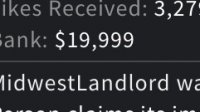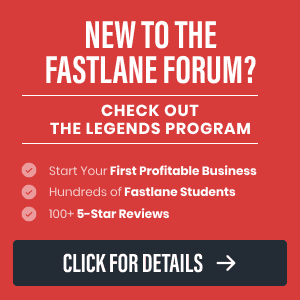MidwestLandlord
Legendary Contributor
EPIC CONTRIBUTOR
Read Fastlane!
Read Unscripted!
Speedway Pass
User Power
Value/Post Ratio
759%
- Dec 6, 2016
- 1,479
- 11,229
@Vigilante mentioned in this thread how he set the price for his new book, and mentioned price points in consumer psychology: Vigilante's Book "Vigilant Kids" Step by Step
I used to consult for a major fastfood chain, and was responsible for pricing with all new franchisee's in the USA. Figure I'd share the knowledge. Of course, I use all this in my B&M too. I assume most of this knowledge would also work for ecom, and I know for a fact they work with selling services as well.
Caution: Long post!
What is a price point?
A price point is just that, the retail price. However, a price point is much more than just the sale price, and there are several strategies you can use when pricing to create the effect you want.
1) Charm Pricing
Charm pricing (also called psychological pricing) is using the specific digits of the price to affect the consumer, and sales, in the way that you wish.
a. Ending pricing.
This is where the price ends in either a '9' or a '5'
Several studies have shown that ending prices in a '9' has resulted in increased sales volume of up to 60.7% compared to evenly priced products. This is why you see $19.99, instead of $20.00
Prices ending in '5' are less common, but have also shown to have positive impacts on sales in the +30% range, again compared to even prices. Obviously, the "best practice" is that if you can price it ending in '5', you can price it ending in '9' and increase your margin with no negative impact.
(Fun Fact: this is why gasoline is priced in the USA with tenths of a cent in the price. $2.299 seems cheaper than $2.30. Also, gas stations used to compete using lower tenths of a cent, like .498 per gallon instead of .499)
Example: A product with a $5 cost and you are after a 50% margin. An exact 50% margin would be $10.00. In this case you would price at $9.99 (seems much cheaper, no?)
b. Dollar Digit
Charm pricing also involves excluding odd numbers in the DOLLAR digit of your price. The theory is that consumers are turned off by odd prices in the dollar digit, and you should hit an even dollar whenever possible (far from a hard and fast rule though)
Example: Instead of pricing an item at $13.99 (an odd '3' in the price) you'd price at either $12.99 or $14.99
2) Price Limits ("that's too expensive!")
This of course depends on what you sell. However, there are several "limits" that consumers will be hesitant to purchase if your price crosses, and your price should be set below or above these limits to account for them.
Common limits are: .50, $1, $5, $7, $10, $13, $15, $20, (every $5 thereafter)
After that, major ones are at $50, $100, $500, $1000
Example: A product with a $6.50 cost and you are after a 50% margin. At margin, your price would be $13.00. $12.99 would work well here as it keeps you under the $13 limit, ends in '9' and has an even dollar digit. Another option if you feel the market would support it is to go to $14.99. This is just like the $12.99, but falls just under the next mental "that's too expensive!" price limit.
As a very soft rule: If they will pay $13.99 (odd dollar), they'd pay $14.99
If they'd pay $15.99 (odd dollar), they'd pay $16.99
3) Decoy Pricing (I use this OFTEN)
This is where you use 2-3 products at different prices, to intentionally drive sales for a certain product.
Example: I'll use Vodka, as Vodka is all pretty much the same...but has multiple price points.
Cheap Vodka: $9.99
Mid-tier Vodka: $14.99
In this example ^^, most people will buy the cheaper option as it is below the $10 mental limit and is cheaper than the only other option. But what if the mid-tier has better margin and you want to sell more?
Cheap Vodka: $9.99
Mid-tier Vodka: $14.99
The good stuff: $19.99
With this example ^^, what mental effect will these prices have on the consumer? The first two Vodka's are exactly the same as the first example after-all...
The result will likely be that most people will purchase the mid-tier Vodka. Why?
1) The cheap Vodka now looks low quality compared to the other two. "I deserve better than that!"
2) The mid-tier Vodka is under a lower mental price barrier compared to the higher priced Vodka. "That's a good deal!"
3) The good stuff looks rather expensive, as it is above the mental price limits of the mid-tier Vodka and the cheap Vodka. "Ohhh that's too much...maybe after my next paycheck!"
You sell more of the product you want to sell, and the others are directing the consumer in the direction you want!
Keep in mind this all applies whether you are the one selecting brands to sell and pricing them (like me), or if you are the brand owner and need an MSRP, or are deciding on pricing compared to the competition for direct sales.
If there's any interest in this, I can cover other strategies I often use(d) like:
Skimming
High-low
Penetration pricing
Price discrimination
Yield management pricing
I used to consult for a major fastfood chain, and was responsible for pricing with all new franchisee's in the USA. Figure I'd share the knowledge. Of course, I use all this in my B&M too. I assume most of this knowledge would also work for ecom, and I know for a fact they work with selling services as well.
Caution: Long post!
What is a price point?
A price point is just that, the retail price. However, a price point is much more than just the sale price, and there are several strategies you can use when pricing to create the effect you want.
1) Charm Pricing
Charm pricing (also called psychological pricing) is using the specific digits of the price to affect the consumer, and sales, in the way that you wish.
a. Ending pricing.
This is where the price ends in either a '9' or a '5'
Several studies have shown that ending prices in a '9' has resulted in increased sales volume of up to 60.7% compared to evenly priced products. This is why you see $19.99, instead of $20.00
Prices ending in '5' are less common, but have also shown to have positive impacts on sales in the +30% range, again compared to even prices. Obviously, the "best practice" is that if you can price it ending in '5', you can price it ending in '9' and increase your margin with no negative impact.
(Fun Fact: this is why gasoline is priced in the USA with tenths of a cent in the price. $2.299 seems cheaper than $2.30. Also, gas stations used to compete using lower tenths of a cent, like .498 per gallon instead of .499)
Example: A product with a $5 cost and you are after a 50% margin. An exact 50% margin would be $10.00. In this case you would price at $9.99 (seems much cheaper, no?)
b. Dollar Digit
Charm pricing also involves excluding odd numbers in the DOLLAR digit of your price. The theory is that consumers are turned off by odd prices in the dollar digit, and you should hit an even dollar whenever possible (far from a hard and fast rule though)
Example: Instead of pricing an item at $13.99 (an odd '3' in the price) you'd price at either $12.99 or $14.99
2) Price Limits ("that's too expensive!")
This of course depends on what you sell. However, there are several "limits" that consumers will be hesitant to purchase if your price crosses, and your price should be set below or above these limits to account for them.
Common limits are: .50, $1, $5, $7, $10, $13, $15, $20, (every $5 thereafter)
After that, major ones are at $50, $100, $500, $1000
Example: A product with a $6.50 cost and you are after a 50% margin. At margin, your price would be $13.00. $12.99 would work well here as it keeps you under the $13 limit, ends in '9' and has an even dollar digit. Another option if you feel the market would support it is to go to $14.99. This is just like the $12.99, but falls just under the next mental "that's too expensive!" price limit.
As a very soft rule: If they will pay $13.99 (odd dollar), they'd pay $14.99
If they'd pay $15.99 (odd dollar), they'd pay $16.99
3) Decoy Pricing (I use this OFTEN)
This is where you use 2-3 products at different prices, to intentionally drive sales for a certain product.
Example: I'll use Vodka, as Vodka is all pretty much the same...but has multiple price points.
Cheap Vodka: $9.99
Mid-tier Vodka: $14.99
In this example ^^, most people will buy the cheaper option as it is below the $10 mental limit and is cheaper than the only other option. But what if the mid-tier has better margin and you want to sell more?
Cheap Vodka: $9.99
Mid-tier Vodka: $14.99
The good stuff: $19.99
With this example ^^, what mental effect will these prices have on the consumer? The first two Vodka's are exactly the same as the first example after-all...
The result will likely be that most people will purchase the mid-tier Vodka. Why?
1) The cheap Vodka now looks low quality compared to the other two. "I deserve better than that!"
2) The mid-tier Vodka is under a lower mental price barrier compared to the higher priced Vodka. "That's a good deal!"
3) The good stuff looks rather expensive, as it is above the mental price limits of the mid-tier Vodka and the cheap Vodka. "Ohhh that's too much...maybe after my next paycheck!"
You sell more of the product you want to sell, and the others are directing the consumer in the direction you want!
Keep in mind this all applies whether you are the one selecting brands to sell and pricing them (like me), or if you are the brand owner and need an MSRP, or are deciding on pricing compared to the competition for direct sales.
If there's any interest in this, I can cover other strategies I often use(d) like:
Skimming
High-low
Penetration pricing
Price discrimination
Yield management pricing
Dislike ads? Remove them and support the forum:
Subscribe to Fastlane Insiders.


